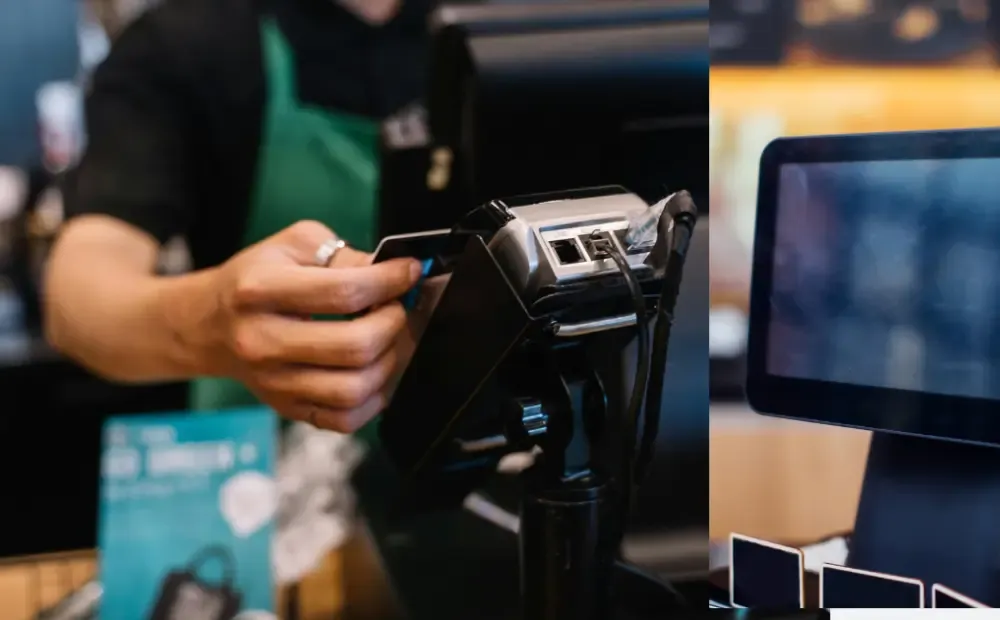If you run a retail shop, restaurant, or franchise, you know speed and accuracy at checkout matters. Without a POS system, your business moves slowly, like a turtle. A POS system isn’t just a digital register. It’s the brain behind your sales, inventory, staff, and customer data.
This guide defines what a POS system is and how its software and hardware work together.
You’ll also learn how it supports different industries and how to choose the right design and supplier. So, keep reading until the end.
What Does POS Re ally Mean in Business?

What is a POS System
A POS system is where your customer makes a payment, and you record the transaction. In other words, it’s a smarter digital cash register.
Modern POS systems track inventory, collect customer data, and manage staff activities. You get real-time sales reports. It’s the tool that keeps your day-to-day business moving.
POS System, Terminal, or Software? Know the Difference
A POS system is the complete setup, comprising both hardware and software that work together.
- The POS terminal is the physical device you and your staff use, like a touchscreen monitor, tablet, or scanner.
- The POS software is the backend system that runs a POS machine. It’s where you enter products, apply discounts, track sales, and view reports.
You can have cloud-based software that works on mobile devices, or a local system tied to a desktop setup. The key is knowing what you need before choosing your tech.
How Different Industries Use POS Every Day
In retail, POS systems track products, handle returns, and manage inventory in real time.
In restaurants, it takes orders, splits bills, and sends tickets straight to the kitchen.
Salons and service-based businesses utilize POS systems to schedule appointments and accept tips. It also helps you manage client records.Regardless of the industry, a POS system helps streamline tasks, minimize errors, and keep your business running smoothly.
How Does a POS System Work? The Full Process Explained

A POS system isn’t just a box that prints receipts. It follows a precise step-by-step process every time you complete a sale. Here’s how each part works together to keep your business running smoothly.
Transaction Flow: From Product Scan to Receipt
A POS system starts working the moment a product is scanned or a service is added. Here’s how the process flows:
- Item Scan or Selection: The cashier scans a barcode or selects an item from the touchscreen display.
- Price + Tax Calculation: The POS software adds up the cost, applies taxes, and updates the running total.
- Payment Method Chosen: The customer pays by card, cash, mobile wallet, or gift card.
- Payment Processed: The POS software connects with the payment processor to approve the transaction.
- Receipt Issued: The system prints or emails a receipt, and the sale is complete.
At the same time, the POS updates inventory, logs the sale, and stores customer data (if enabled). All of it happens in seconds.
Role of Hardware + Software Working Together
A POS system only functions effectively when its hardware and software communicate smoothly. Each part plays a role:
- Hardware handles the inputs, including barcode scanners, receipt printers, card readers, and touchscreens.
- The software runs behind the scenes. It manages prices, syncs inventory, tracks reports, and processes payments.
- You need both. A great POS system is not just one app or one machine—it’s the whole setup working in sync.
Cloud-Based & Real-Time Operations
Modern POS software runs in the cloud. That means:
- You can track sales from any location…on a phone, tablet, or laptop.
- Your data syncs instantly across all devices.
- Updates happen automatically, without downtime.
Cloud-based POS keeps your business flexible, fast, and connected—whether you’re behind the counter or on the go.
Core Components of a POS System (Hardware + Software)
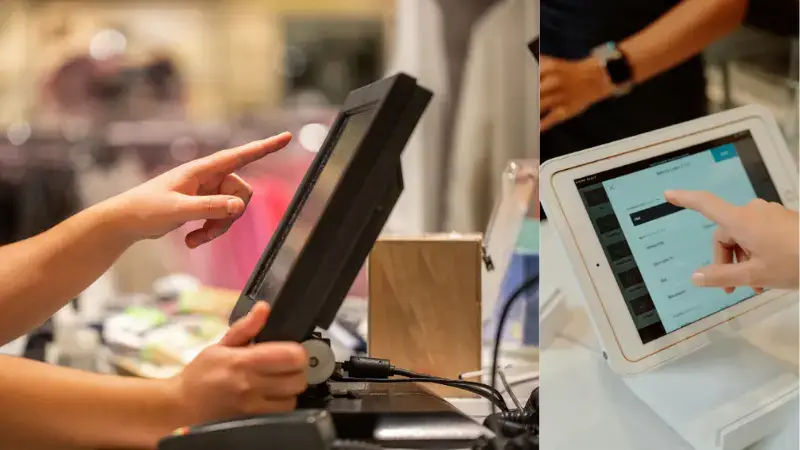
Every POS system operates on two essential layers: the hardware you see and the software that powers it. Together, they handle sales, payments, and business operations seamlessly.
Here’s what you need to know before choosing or upgrading your setup.
POS Hardware
POS hardware makes up the physical tools used at the checkout counter.
Most systems include:
- Touchscreen monitor: For order entry, employee logins, and quick access to software functions.
- Barcode scanner: Accelerates product lookup and minimizes manual errors.
- Receipt printer: Prints proof of purchase for customers, using either thermal or dot-matrix technology.
- Cash drawer: Stores physical cash securely and opens only when needed.
- Payment terminal: Accepts credit cards, debit cards, mobile wallets, and tap-to-pay services.
Each piece seamlessly integrates with your POS software for a smooth checkout experience.
POS Software Modules
The software ties everything together. Good POS systems go beyond ringing up sales.
Look for built-in tools like:
- Inventory management: Tracks stock levels in real-time and alerts you on low stock.
- Customer relationship management (CRM): Stores customer details, order history, and preferences.
- Employee management: Controls access, tracks hours, and monitors staff performance.
- Analytics and reporting: Offers insights on sales trends, peak hours, and top-performing products.
These features help you work smarter and make better decisions daily.
Payment Processing Integrations
Your POS must connect with secure and flexible payment processors.
Strong integrations ensure:
- Fast, encrypted transactions
- Support for credit cards, debit cards, mobile wallets, and split payments
- Real-time syncing with your accounting or invoicing tools
Look for systems that meet PCI-DSS compliance standards. Many modern POS setups integrate with trusted platforms like Square, Stripe, or Clover. And help you stay compliant while providing your customers with more payment options.
Types of POS Systems Explained

Point of Sale (POS) systems come in various forms, each designed to meet specific business needs.
The type of POS system you use significantly impacts how you serve customers, whether you’re running a retail chain, a food truck, or a fast-paced café.
Traditional On-Premise POS
This setup runs on local servers and stores all data in-house. It’s often installed and maintained by IT teams.
Retail chains and full-service restaurants still rely on it for one main reason: full control. These systems support custom workflows and complex setups, but they also come with higher upfront costs and maintenance demands.
Cloud-Based POS
This is the most popular setup today. All data lives in the cloud, and you access it through a browser or app. There’s no need for bulky servers or constant manual updates.
Key benefits:
- Scales easily across locations
- Real-time access to reports and inventory
- Automatic software updates
- Remote support and login
It works well for fast-moving retail and hospitality businesses that want flexibility.
Mobile POS Systems
Mobile POS setups turn tablets or smartphones into checkout stations. You can ring up sales, check inventory, or print receipts from the floor—or even the sidewalk.
These systems are perfect for:
- Busy shops needing line-busting solutions
- Restaurants offering table-side checkout
- Pop-ups, food trucks, and curbside service
They’re fast, affordable, and easy to train staff on.
Self-Service Kiosks & Hybrid Models
Self-service kiosks enable customers to place orders, pay, and check out independently. They’re everywhere in fast food and grocery stores.
Hybrid POS models integrate touchscreen counters, mobile devices, and kiosks into a single system.
This setup is ideal for high-volume environments, such as QSRs and large retailers, where speed and customer choice are non-negotiable.
POS Software Features That Drive Business Efficiency
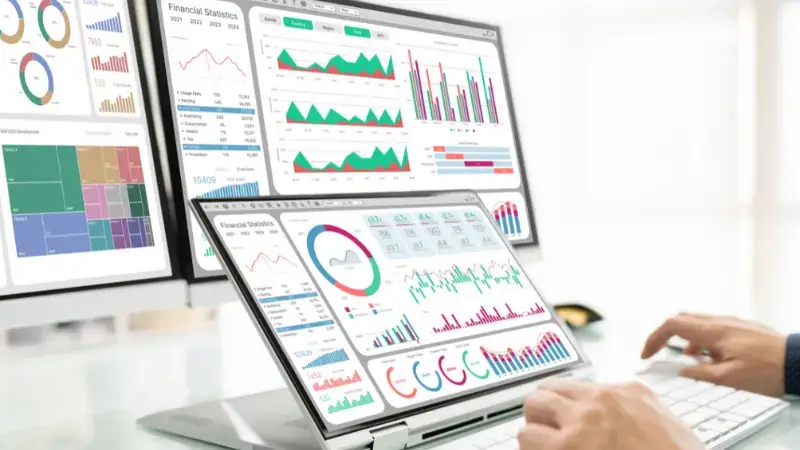
Smart POS software gives you control over inventory, customers, and multi-location performance. The right features help you save time, reduce mistakes, and grow your margins.
Inventory Management & Auto-Stocking
Good POS software keeps your shelves stocked without requiring you to count items manually. It tracks stock levels in real time, alerts you when items are running low, and can even reorder products automatically.
For example:
Shopify POS sends restock alerts and syncs inventory across your store and website.
This helps you avoid overselling and losing revenue due to out-of-stock items.
CRM, Loyalty Programs, and Personalized Offers
Modern POS systems store customer data, allowing you to understand buying habits and reward repeat visits. Many platforms let you:
- Track individual customer profiles.
- Launch loyalty programs
- Send targeted discounts based on past purchases.
For Example:
Toast POS offers built-in loyalty modules that integrate seamlessly with online ordering and in-person sales.
These tools help increase return visits and average ticket size.
Business Intelligence & Sales Dashboards
Real-time dashboards provide a comprehensive view of your sales, refunds, and bestsellers. You can compare day-to-day or week-over-week performance to spot patterns.
You don’t need to export data or wait for reports. The numbers are always live and accessible.
Multi-Store & Franchise Control Features
Running multiple locations? Look for a POS that centralizes control.
The best systems allow you to:
- Share product catalogs across stores.
- Track performance per location
- Manage employee roles and permissions.
This is essential for franchise owners or retailers scaling up. You stay in control while store managers focus on the floor.
POS Systems for Retail: Use Cases & Industry Fit
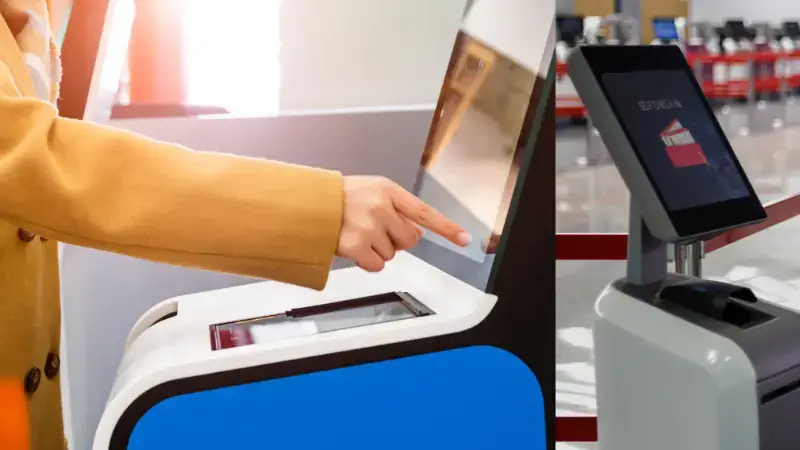
Retail environments need fast, flexible, and accurate tools to stay competitive. A well-fitted POS system helps you manage product-heavy operations. And support your staff, while also improving the checkout experience.
Specific Use Cases: Fashion, Grocery, Electronics, Pop-Ups
Retail POS systems vary depending on your product mix and operational needs.
- Fashion stores rely on POS tools to manage product variations like size, color, and brand. Systems with smart inventory and customer tagging help track seasonal trends and repeat buyers.
- Grocery stores use POS systems built for speed. High-volume stores need built-in barcode scanners, weight scale support, and EBT payment options. These features streamline checkout and ensure transactions run smoothly.
- Electronics retailers often need serial number tracking, warranty tools, and bundling features. These help manage complex setups, product returns, and service claims.
- Pop-up shops and market vendors rely on mobile POS systems. Wireless connectivity, simple inventory sync, and quick setup keep them flexible and fast-moving.
Retail-Only Benefits: Barcode Support, Returns, Inventory Syncing
Retail environments come with unique challenges. POS systems built for retail provide features that tackle these head-on:
- Barcode scanning speeds up checkout and reduces pricing errors.
- Integrated return and refund workflows enable staff to process exchanges efficiently without disrupting the queue.
- Inventory syncing across sales channels ensures accurate stock levels and prevents overselling.
Without these tools, retailers risk losing sales, customer frustration, and stock mismanagement.
Checkout Experience Enhancements: Speed, Customer Data Capture
The retail checkout is your last chance to leave a good impression…and a smart POS helps make it count. Fast payment processing helps cut down lines. Built-in CRM features let staff personalize each transaction.
Modern POS systems collect customer data at checkout (with consent). You can use this data to email receipts, apply loyalty rewards, or suggest products based on past purchases.
What to Look for in POS Design and Hardware Setup
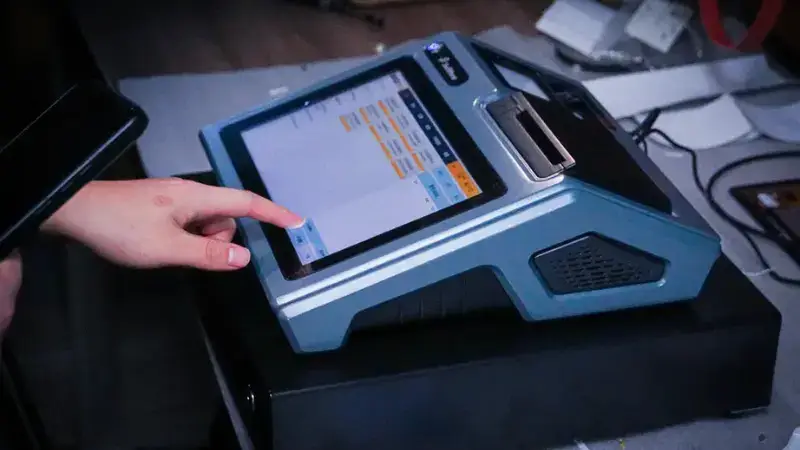
A well-designed POS system speeds up transactions, cuts down staff errors, and makes checkout smoother.
When choosing a POS, don’t just focus on features. Consider how the design aligns with your space, team, and brand.
UI/UX for Staff Efficiency and Onboarding
Your team shouldn’t spend hours learning the POS system.
A clean, easy-to-use interface helps staff ring up sales quickly, find products faster, and avoid mistakes.
Good design also shortens training time for new hires. It is crucial in high-turnover industries like retail and hospitality.
Brand-Consistent Themes and Custom Layouts
POS systems should blend seamlessly into your brand, not stand out like an outdated calculator. Many modern systems allow you to:
- Match colors and logos to your store design
- Adjust product grids or menu layouts for speed
- Set custom workflows for different roles (cashier vs. manager)
This creates a smoother experience for both staff and customers.
Hardware That Fits Your Physical Space
POS hardware must work with your actual counter layout. Make sure the monitor, payment terminal, and receipt printer fit without crowding your checkout space. Cables should be kept out of the way, and devices should be easily accessible. If your business operates on mobile devices or features self-checkout, the design must also adapt to these setups.
How to Choose the Right POS Supplier or Vendor

Not every vendor is built for long-term support. Some offer an all-in-one solution that includes hardware, software, and services. Others just resell generic systems with little insight into your business needs. If you want a POS that works day-to-day, the vendor behind it matters just as much as the product.
Features to Look for in a POS Vendor
The right supplier should bring more than sales talk. Look for:
- Responsive support: especially during your peak business hours.
- Integration flexibility: with your accounting, CRM, inventory tools, and more.
- Ongoing updates: regular patches and feature upgrades to stay secure and current.
- Clear pricing: no hidden fees, unexpected licensing costs, or support charges.
A vendor that checks these boxes will grow with your business, rather than holding it back.
Leading Providers Overview
Some of the most trusted POS providers include:
- SwiftForce: Known for reliable build quality, scalable hardware solutions, and fast shipping for global businesses.
- Square: Flexible and affordable for small businesses and pop-ups.
- Clover: Simple setup, ideal for fast-moving retail or QSR.
- Toast: Designed for restaurants with detailed kitchen and table tools.
Each one brings a unique edge. Focus on how the provider fits into your daily operations and long-term growth, not just brand recognition.
Supplier, Reseller, or Manufacturer? Know the Difference
Here’s where most buyers get confused.
A supplier usually sells directly and offers setup, onboarding, and support.
A reseller may get you better pricing but often passes support off to someone else.
A manufacturer builds the hardware or software and may or may not offer direct service.
Whenever possible, choose a vendor who understands your industry and will remain involved after the sale. That’s how you avoid costly integration mistakes later.
Common POS System FAQs
Q1: What does POS stand for?
POS stands for Point of Sale. It’s where a customer makes a payment for goods or services.
Q2: What is the difference between POS hardware and software?
POS hardware refers to the physical tools, like scanners, receipt printers, and payment terminals.
POS software is a program that runs transactions, tracks inventory, and manages business data.
Q3: What POS system is best for small businesses?
It depends on your industry. For example:
- Square works well for pop-ups and mobile sellers.
- SwiftForce offers scalable hardware options for growing operations.
- Toast is ideal for small restaurants.
Q4: How much does a POS system cost?
Basic systems start around $0 to $100/month for software. Hardware can range from $300 to $2,000+, depending on complexity.
Q5: What industries benefit most from POS solutions?
Retail, restaurants, salons, service providers, and even healthcare use POS systems to simplify sales, inventory, and customer data tracking
Final Take: Choose a POS That Grows With You
The fastest-moving businesses adapt, track, and optimize in real-time. That’s what a smart POS system makes possible. It unlocks better margins, smoother workflows, and sharper customer experiences.
If your current system can’t keep up with your goals, it’s already holding you back.
Ready to explore a POS system for your business?
Visit SwiftForce POS Solutions …designed for businesses that want more control, more speed, and more room to grow.
Have questions? Contact us today for expert guidance.

